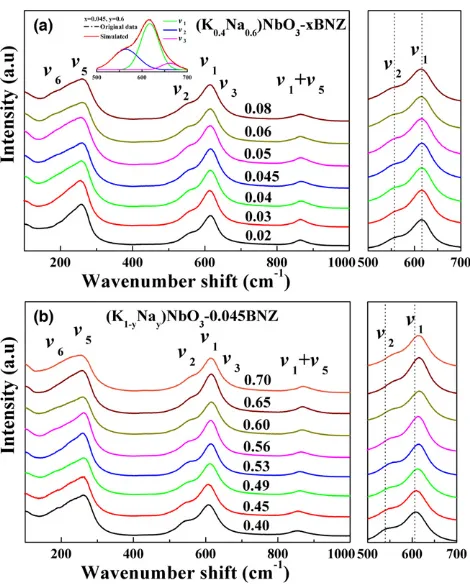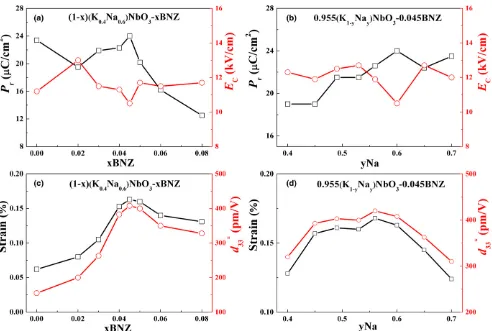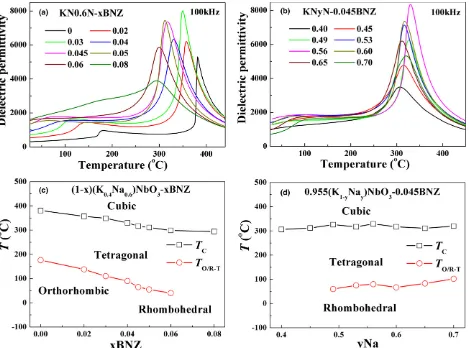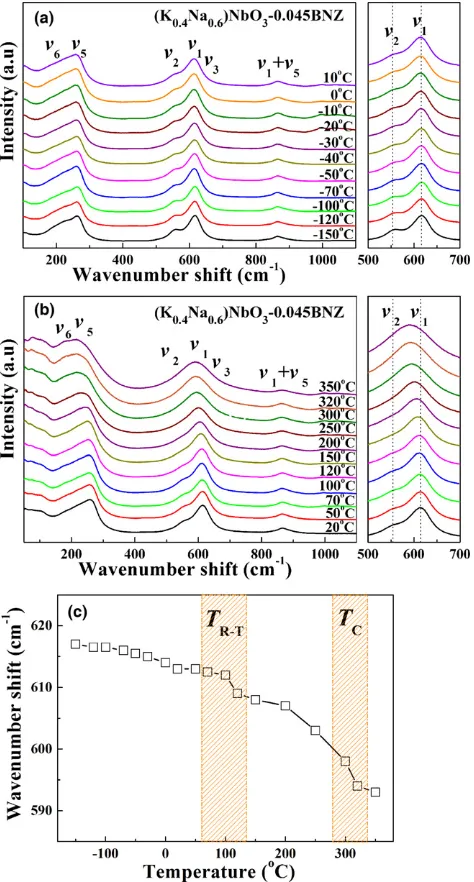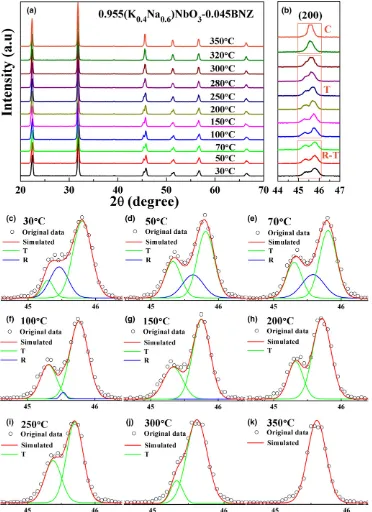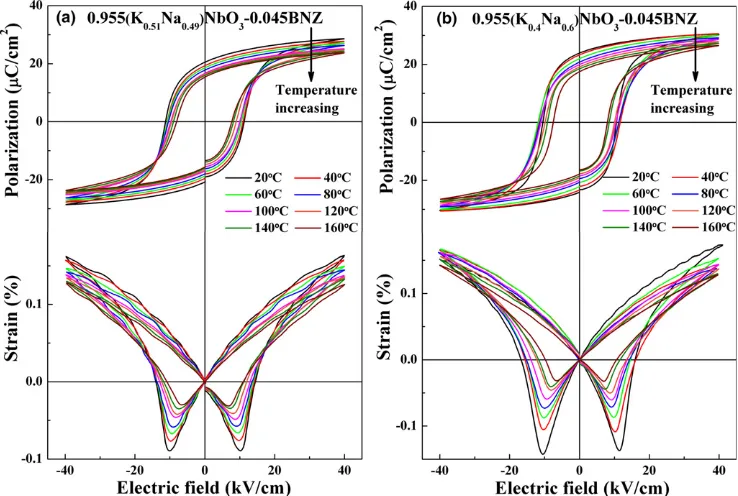Composition and temperature dependence of structure
and piezoelectricity in
(1−x)(K1−yNay)NbO3-x(Bi1/2Na1/2)ZrO3 lead-free ceramics
WANG, Dawei, HUSSAIN, Fayaz, KHESRO, Amir, FETEIRA, Antonio
<http://orcid.org/0000-0001-8151-7009>, TIAN, Ye, ZHAO, Quanliang and
REANEY, Ian
Available from Sheffield Hallam University Research Archive (SHURA) at:
http://shura.shu.ac.uk/13871/
This document is the author deposited version. You are advised to consult the
publisher's version if you wish to cite from it.
Published version
WANG, Dawei, HUSSAIN, Fayaz, KHESRO, Amir, FETEIRA, Antonio, TIAN, Ye,
ZHAO, Quanliang and REANEY, Ian (2017). Composition and temperature
dependence of structure and piezoelectricity in
(1−x)(K1−yNay)NbO3-x(Bi1/2Na1/2)ZrO3 lead-free ceramics. Journal of the American Ceramic Society,
100 (2), 627-637.
Copyright and re-use policy
See
http://shura.shu.ac.uk/information.html
Sheffield Hallam University Research Archive
Composition and Temperature Dependence of Structure and Piezoelectricity
in (1
–
x)(K
1–yNa
y)NbO
3-x(Bi
1/2Na
1/2)ZrO
3Lead-Free Ceramics
Dawei Wang,
‡,§Fayaz Hussain,
‡Amir Khesro,
‡Antonio Feteira,
¶Ye Tian,
kQuanliang Zhao,
§and
Ian M. Reaney
‡,† ‡Department of Materials Science and Engineering, University of Sheffield, Sheffield S1 3JD, UK§Department of Materials Science and Engineering, North China University of Technology, Beijing 100144, China
¶Christian Doppler Laboratory for Advanced Ferroic Oxides, Sheffield Hallam University, Sheffield S1 1WB, UK
kSchool of Engineering and Materials Science, Queen Mary University of London, London E1 4NS, UK
Lead-free piezoceramics with the composition (1–x)(K1–yNay) NbO3-x(Bi1/2Na1/2)ZrO3 (KNyN-xBNZ) were prepared using a conventional solid-state route. X-ray diffraction, Raman spectroscopy, and dielectric measurements as a function of temperature indicated the coexistence of rhombohedral (R) and tetragonal (T) phase, typical of a morphotropic phase boundary (MPB) as the BNZ concentration increased and by adjusting the K/Na ratio. High remnant polarization (Pr=24 lC/cm2), piezoelectric coefficient (d33=320 pC/N), effective piezocoeffi-cient (d33 =420 pm/V), coupling coefficient (kp=48%), and high strain (S=0.168%) were obtained at room temperature, but significant deterioration of Pr, d33, and kp were observed by increasing from room temperature to 160°C (17.5lC/cm2, 338 pm/V, and 32%, respectively) associated with a transition to a purely T phase. Despite these compositions showing pro-mise for room-temperature applications, the deterioration in properties as a function of increasing temperature poses chal-lenges for device design and remains to be resolved.
Keywords: lead-free ceramics; piezoelectric materials/proper-ties; potassium-sodium niobate/KNN
I. Introduction
P
IEZOELECTRIC materials have being extensively investi-gated because of their widespread applications ranging from medical, environmental, and industrial process monitor-ing to robotics, energy harvestmonitor-ing, and high-frequency com-munication systems.1,2 Most commonly used materials are based on lead zirconate titanate Pb(Zr,Ti)O3 (PZT) due totheir high piezoelectric performance.3–5However, regulations against hazardous substances such as lead in electric and electronic equipment has stimulated research in lead-free piezoelectrics over the last two decades.6–14
Potassium-sodium niobate (K,Na)NbO3 (KNN) is one of
the leading candidates to replace PZT and has been exten-sively investigated due to its moderately large piezoelectric coefficient (d33) and high Curie temperature (TC),15,16 since
its discovery in the 1950s.17In particular, research on KNN
accelerated when Saito et al. (2004) reported giant d33
416 pC/N, comparable to those of PZTs, in textured (Li,Ta,
Sb)-modified KNN,18,19 However, disadvantages such as attaining well-densified ceramics due to the high volatility of the alkaline components and low piezoelectric properties in polycrystalline ceramics have prevented KNN being commer-cialized.20–24 In general, dopants in KNN enhance
piezoelec-tricity (d33>200 pC/N) by pushing the orthorhombic (O) to
tetragonal (T) transition boundaries closer to room tempera-ture.25–44This effect is well documented for dopants such as LiSbO3, LiTaO3, Bi0.5Na0.5TiO3, and BaTiO3.
25–32
But coex-istence of rhombohedral (R) and O phases has been reported for dopants with the general formula AZrO3 (A=Ba, Sr, or
Ca) or BiMO3(M=Fe, Sc, Co).33–38Compositions which rely
on R-O coexistence generally, however, exhibitd33≤230 pC/
N that are significantly lower the compositions which utilize the O-T phase boundary to optimized33.
Recently, PZT-like morphotropic phase boundary (MPBs) (R-T) have been reported in KNN-based ceramics by inte-grating compositions which were previously used to optimize the O-T and R-O phase boundaries.39–50In 2011, Zuo et al. reported R-T phase coexistence in (Li,Ta,Sb) and BaZrO3
multimodified KNN lead-free ceramics and obtained a high
d33=365 pC/N.39–41 For similar compositions, Wu et al.
obtained d33 425 pC/N.42 But more recently, Sb together
with (Bi,M)NO3 (M=Na, K, Li, Ag, N=Zr, Hf, Sn) have
been used to enhance d33 and electromechanical strain (S)
withd33andS improved to>400 pC/N and 0.46% at 3 kV/
cm, respectively.43–49 Despite promising d33 and S values
there are still a number of concerns. For Sb doping, TC is
reported to decrease alarmingly and de-poling may jeopar-dize some applications. More importantly, however, to our knowledge, the temperature dependence of the piezoelectric properties is rarely reported. It is likely that the supposed MPB in many KNN-based compositions is not temperature independent and therefore phase coexistence and high d33/S
are not maintained during high-temperature applications or at high field cyclic loading in which temperature is likely to increase. Given the above concerns, this contribution pre-sents the composition and temperature dependence of the piezoelectric properties (1x)(K1yNay)NbO3-x(Bi1/2Na1/2)
ZrO3 (KNyN-xBNZ) lead-free ceramics in which LiSbO3
dopants have been excluded to maintain a highTC.
II. Experimental Procedure
The KNyN-xBNZ ceramics with compositions of (1x) (K1yNay)NbO3-x(Bi1/2Na1/2)ZrO3 (x=0, 0.02, 0.03, 0.04,
0.045, 0.05, 0.06, 0.08, and y = 0.6) and (x = 0.045, and
y=0.4, 0.45, 0.49, 0.53, 0.56, 0.6, 0.65, and 0.7) were pre-pared using a conventional solid-state reaction. Raw materi-als, including Na2CO3 (99.9%, Fisher Scientific), K2CO3 S. Zhang—contributing editor
Manuscript No. 38841. Received July 8, 2016; approved September 8, 2016.
†Author to whom correspondence should be addressed. e-mail: i.m.reaney@
sheffield.ac.uk
1
J. Am. Ceram. Soc.,1–9 (2016) DOI: 10.1111/jace.14589
©2016 The Authors.Journal of the American Ceramic Societypublished by Wiley Periodicals, Inc. on behalf of American Ceramic Society (ACERS) This is an open access article under the terms of the Creative Commons Attribution License, which permits use, distribution and reproduction in any medium, provided the original work is properly cited.
(99.7%, Fisher Scientific), Nb2O5 (99.5%, Sigma-Aldrich),
ZrO2 (99%, Sigma-Aldrich), and Bi2O3 (99.9%,
Sigma-Aldrich) were batched stoichiometrically according to the nominal compositions and ball-milled in isopropanol for 24 h. The dried mixed powders were calcined at 850°C for 6 h to synthesize the compound and then ball milled in isopropanol
for 12 h. The calcined powders were mixed with a polyvinyl alcohol (PVA) binder solution, granulated and pressed into pellets with 10 mm in diameter. Following binder burnout at 550°C, the pellets were sintered in a sealed crucible with sacri-ficial powders at 1150°C–1230°C for 3–6 h.
The density of the sintered samples was measured by the Archimedes method. The relative density of all studied samples was higher than 95%. The phase structure of the sintered samples was studied using a Bruker D2 Phaser X-ray powder diffraction (XRD) and in situ XRD performed for selected samples using a Siemens D5000 HTXRD in the temperature range 30°C–350°C. Ceramic morphology and microstructure was examined using an FEI Inspect F scan-ning electron microscope (SEM). Raman spectra were acquired from 150°C to 350°C using a Renishaw inVia Raman microscope. For electrical tests, sintered samples were electroded using fire-on silver paste, followed by the samples being poled in silicon oil at room temperature with an applied electric field of 30–40 kV/cm. Piezoelectric coeffi-cient (d33) was measured using a Piezotest PM300 d33 meter.
Polarization hysteresis and strain-electric field behavior were determined using an aixACCT TF 2000 ferroelectric tester at a frequency of 1 Hz from room temperature to 160°C. The displacement data were synchronously captured by a laser interferometer. The temperature-dependent dielectric permit-tivity from 25°C to 600°C was measured using an Agilent 4184A multifrequency precision LCR meter. The planar elec-tromechanical coupling factor (kp) was determined from the
resonance and antiresonance frequencies, which were mea-sured using an Agilent 4294A Impedance/Gain-phase ana-lyzer according to IEEE standards on piezoelectricity.51,52
III. Results and Discussion
(1) Compositional Evolution of Structure–Property Relations
[image:3.595.297.532.38.330.2]The room-temperature XRD patterns of KNyN-xBNZ in the 2h range of 20°–70° are shown in Fig. 1. All peaks
[image:3.595.32.267.43.404.2]Fig. 1. Room temperature XRD patterns of KNyN-xBNZ (a) KN0.6N-xBNZ and (b) KNyN-0.045BNZ; amplified XRD patterns simulated by Gaussian for (c) 0.02BNZ (d) KN0.06N-0.045BNZ (e) KN0.06N-0.08BNZ.
[image:3.595.32.269.462.646.2]Fig. 2. Rietveld refinement analysis of KN0.6N-0.045BNZ using the GSAS+EXPGUI package. Two phasesR3c+P4 mmwere used. Rp =6.2%,Rwp=9.7% andv2=1.88.
Fig. 3. Room temperature Raman spectra of KNyN-xBNZ (a) KN0.6N-xBNZ, inset shows the Raman amplified peaks around 600 cm1simulated by Gaussian and (b) KNyN-0.045BNZ.
could be attributed to perovskite phases, indicating that a stable solid solution was formed in the studied range. Diffraction peaks shifted to a lower and higher diffraction angle with increasing BNZ and Na concentration, respec-tively, consistent with differences in relative ionic radius of the dopant/substituent ions with the matrix composition.
[image:4.595.126.496.44.288.2]Splitting of (200) peak at ~2h=45° was used to determine the likely symmetry of compositions. In the expanded XRD patterns [Fig. 1(a)], O phase was dominant in KN0.6N-xBNZ with x≤0.02, but R, O and T phases coexisted for compositions of 0.03≤ x ≤0.04. As x increased further, ceramics with 0.045≤ x ≤0.05 showed mixed R and T
Fig. 4. High electric field bipolar polarization hysteresis and strain loops for KNyN-xBNZ (a) KN0.6N-xBNZ and (b) KNyN-0.045BNZ.
Fig. 5. Ferroelectric and strain properties of KNyN-xBNZ (a)PrandECas a function of BNZ, (b)PrandECas a function of Na, (c)Sand
d33as a function of BNZ, (d)Sandd33 as a function of Na.
[image:4.595.66.558.320.651.2]Fig. 6. Dielectric and piezoelectric properties of KNyN-xBNZ (a)erand tandas a function of BNZ, (b)erand tandas a function of Na, (c)d33
andkpas a function of BNZ, (d)d33andkpas a function of Na.
Fig. 7. Temperature dependence oferand tandfor KNyN-xBNZ (a) KN0.6N-xBNZ, (b) KNyN-0.045BNZ, (c)TCandTO/R-Tas a function of
BNZ, (d) (c)TCandTO/R-Tas a function of Na.
[image:5.595.51.521.384.732.2]phases. For x>0.05, a single peak emerged, suggesting that R phase dominated. For compositions in which x was maintained at 0.045 (KNyN-0.045BNZ), the splitting of (200)/(002) peaks gradually disappeared as y increased, sug-gesting the coexistence of R and T for a wide variation in Na:K ratio, Fig. 1(b). To confirm the phase evolution in KNyN-xBNZ as a function of composition, simulations were performed, Fig. 1(c–e), which are consistent with experimental data and also the interpretation by Wang et al.43–50 Rietveld refinement analysis of the MPB compo-sition KN0.6N-0.045BNZ was also performed using the GSAS+EXPGUI package,53,54 where a two phases refine-ment (R3c +P4 mm) was used, as shown in Fig. 2. A good agreement between the observed and calculated patterns was obtained with Rp=6.2%, Rwp=9.7% and chi-squared
(v2)=1.88, indicating the coexistence of R (R3c, 32.5%)
and T (P4 mm, 67.5%) phases in the MPB composition. To further confirm phase evolution as a function of com-position, room-temperature Raman spectra of KNyN-xBNZ ceramics were obtained as shown in Fig. 3. Among the full Raman active mode of KNN, m1, m2, and m3 are stretching modes, m5 and m6 are bending modes of the NbO6
octahedra.55 The strongest peak around 600 cm1 is related to them1 mode; whereas the left and right weaker peaks are assigned to them2andm3mode, respectively, as indicated by the simulated data shown in the inset of Fig. 3(a). With increasing BNZ content, the m1 andm2 peaks were found to shift to lower wave number as shown in Fig. 3(a). On the other hand, them1andm2peaks shift to higher wave number with an increase in Na content as shown in Fig. 3(b). The peak shift to a lower/higher frequency is due to an increase/ decrease in binding strength caused by the expansion/shrink-age of the distance between Nb5+ and its coordinated
oxy-gen, resulting in the corresponding variation in crystal cell volume.55,56 However, the clear but gradual symmetry
changes observed by XRD were not apparent in the Raman spectra, as evidenced by the absence of the appearance of new symmetry related modes. Raman, however, is not only sensitive to the macroscopic symmetry but is influenced strongly by local distortions to the lattice. It is postulated that within the KNyN-xBNZ system there are compositional regions dominated by “pseudosymmetry” in a manner dis-cussed for La-doped BiFeO3compositions by Khesro et al.57
and Bi1/2(K1xNax)1/2TiO3 by Levin and co-workers.58,59 In
these compositions, there are local perturbations in the aver-age macroscopic symmetry more commonly associated with adjacent phases within the phase diagram, for example, short-range antipolar order in the paraelectric phase for La-doped BiFeO3. We propose a similar model for
KNyN-xBNZ based on the absence of new symmetry modes in Raman and the gradual changes in peak splitting in XRD but extensive transmission electron microscopy (TEM) work is required before this can be proved conclusively.
The SEM images for the surface of KNyN-xBNZ ceramics (not shown) revealed that the grain size of KN0.6N-xBNZ decreased with increasing BNZ content, from ~5lm for
x=0 and to ~1lm for x =0.08 but the grain size of KNyN-0.045BNZ was insensitive to the K/Na ratio.
The high electric field bipolar polarization hysteresis and strain loops for KNyN-xBNZ as a function of BNZ and Na content are shown in Fig. 4, from which the remnant polar-ization (Pr), coercive field (EC) and average electric field
induced strain (S) as a function of BNZ and Na content can be obtained, Fig. 5. The normalized strain coefficient d33, representing the average strain per unit of electric field, is calculated by, d33¼Smax=Emax, where Emax is the maximum
electric field value, and Smax is the average value of the
cor-responding maximum strain. As shown in Fig. 5(a and b), with increasing BNZ and Na concentration in KNyN-xBNZ,
Princreased and then decreased after reaching a peak value,
at which point the lowestECwas obtained. The highest value
of Pr =24lC/cm 2
and lowest value of EC =10.5 kV/cm
was achieved for x =0.045, y=0.6 at the MPB.60,61 The S
and d33 values increased with increasing BNZ and Na con-tent, reaching maximum values of 0.163%, 408 pm/V at
x=0.045, y=0.6 and 0.168%, 420 pm/V at x=0.045,
y=0.56, respectively, above which they reduced, Fig. 5(c and d).d33 is dominated by extrinsic effects, mainly domain wall motion, which the coexistence of R and T phases encourages at the MPB.61–63
The dielectric and piezoelectric properties of KNyN-xBNZ as a function of BNZ and Na content are shown in Fig. 6. The room-temperature permittivity (er) of KN0.6N-xBNZ increases with BNZ concentration, whereas it ini-tially increases and then decreases as a function Na/K ratio, Fig. 6(a and b). tand initially decreased with BNZ and Na concentration but then became stable for a broad range of compositions, Fig. 6(a and b). d33 and kp both
increased significantly with increasing BNZ and Na concen-tration as shown in Fig. 6(c and d), reaching a maxima of 310 pC/N and 48% for x =0.045, y=0.06, and 320 pC/N and 50% for x=0.045, y=0.056, respectively, and then decreasing for BNZ>0.05 and Na >0.6. As with d33, d33
[image:6.595.63.300.42.483.2]is optimized at the MPB largely through extrinsic
Fig. 8. In situ temperature dependence of Raman spectra for KN0.6N-0.045BNZ (a) 150°C–10°C, (b) 20°C–350°C, (c) m1 peak
shift as a function of temperature.
contributions. The facile rotation of the polarization vector between states of similar free energy facilitated by phase coexistence, allows the domain walls to displace reversibly, resulting in a strong extrinsic contribution to the piezoelec-tric properties.61,64
(2) Evolution of Structure–Property Relations as a Function of Temperature
The temperature dependence of dielectric permittivity and loss for KNyN-xBNZ with different BNZ concentration and K/Na ratio is given in Fig. 7. It is well-known that KNN exhibits two dielectric peaks above room temperature, corre-sponding to the ferroelectric O-T phase transition at~176°C (TO-T) and the T-cubic (C) phase transition at~381°C (Curie
temperature, TC). With increasing BNZ concentration, the
maximumeratTC(emax) increased andTCdecreased
contin-uously, meanwhile,TO-Tdecreased and merged with the
fer-roelectric R-O phase transition (TR-O), resulting in
coexistence of R and T phases at room temperature, Fig. 7(a,c), which is consistent with the XRD results (Fig. 1) and previous reports.43–50 However, TC remained at ~310°C
and TR-T increased with increasing Na concentration,
[image:7.595.99.471.42.554.2]sug-gesting the K/Na ratio had little effect on the ferroelectric-paraelectric phase transition of KNyN-xBNZ and that its major influence is on lower temperature transitions. We note also that broad relaxor-like peaks are observed in all compo-sitions if the BNZ concentrations exceeds,x =0.08. Relaxor behavior, however, is not the focus of this study and we note only that KNyN-xBNZ follows trends typically observed in ferroelectric to relaxor compositional transitions with a transformation from a clearly defined macroscopic symmetry
Fig. 9. In situtemperature dependence of XRD patterns for KN0.6N-0.045BNZ (a) 2h=20°–70°, (b) 2h=44°–47°; simulations of splitting of the{200}peaks with different temperatures (c) 30°C, (d) 50°C, (e) 70°C, (f) 100°C, (g) 150°C, (h) 200°C, (i) 250°C, (j) 300°C, and (k) 350°C.
(x =0) to pseudosymmetry (x>0.08) that is associated with loss of long range ferroelectric order through chemical disor-der that induces local competition/frustration between phases of similar free energy.
To clarify the structural evolution of KNyN-xBNZ as a function of temperature, in situ temperature dependence of Raman and XRD measurements for the selected MPB com-position KN0.6N-0.045BNZ were performed, the results from which are plotted in Figs. 8 and 9. As shown in Fig. 8, the general trend is that the m1 peak shifted to lower wave number and broadens, accompanied by a gradual fading of them2peak. More specifically, them1peak [Fig. 8(c)] revealed a gradual shift in frequency (wave number) up to 70°C– 100°C after which there was a sharp change in frequency, coincident with the broad peaks in er at the same tempera-ture range in Fig. 7.
In situ high-temperature XRD data for KN0.6N-0.045BNZ is shown in Fig. 9 which focused on evolution of splitting of the{200} peaks. Phase coexistence was apparent at room temperature as shown by broad multiple peaks that gradually disappeared to become a single peak at high tem-peratures in the cubic phase. To confirm the phase evolution as a function of temperature, simulations were performed, Fig. 9(c–k). As temperature increased, the coexistence of R-T phases remained up to 70°C–100°C, after which the phase structure total transformed to a T and then C phase above
TC, consistent with experimentalerand Raman spectroscopy
data as function of temperature.
The in situ temperature dependence of high electric field bipolar polarization hysteresis and strain loops for two MPB compositions (KN0.49N-0.045BNZ and KN0.6N-0.045BNZ) are shown in Fig. 10, from which the Prand d33 as a func-tion of temperature were obtained, Fig. 11. As temperature increased,Pr andd33 for both MPB compositions decreased linearly, coincident with a similar temperature dependence of
kp, as shown in the inset of Fig. 11. The piezoelectric effect
in ferroelectric ceramics is attributed to both intrinsic (lattice deformation) and extrinsic (domain wall motion) contribu-tions. Normally, Pr reflects intrinsic contribution, and d33 and kp contain both components.40,48 However, detailed
[image:8.595.126.495.43.291.2]knowledge of the domain morphology is required to fully appreciate how the extrinsic contributions is likely to vary as a function of temperature and composition and extensive transmission electron or piezoforce microscopy is required. Nonetheless, the data presented in this contribution clearly illustrates that KNN-BNZ suffers from extreme temperature
[image:8.595.63.300.342.655.2]Fig. 10. In situtemperature dependence of high electric field bipolar polarization hysteresis and strain loops for two MPB compositions (a) KN0.49N-0.045BNZ and (b) KN0.6N-0.045BNZ.
Fig. 11. Pr and d33 as a function of temperature for
KN0.49N-0.045BNZ and KN0.6N-KN0.49N-0.045BNZ, inset shows the temperature dependence ofkp.
dependence which may inhibit its usage in high drive applica-tions and high-temperature applicaapplica-tions despite the attractive values ofkpandd33at room temperature.
IV. Conclusion
In this work, KNN based lead-free ceramics with the composi-tion (1x)(K1yNay)NbO3-x(Bi1/2Na1/2)ZrO3 were
success-fully prepared by a conventional solid-state route. With the increase in BNZ content, the phase structure of KNN gradu-ally transformed from O to mixed R-T and then R phase, indicative of the construction of an R-T based MPB with 0.045≤ BNZ≤0.05 and 0.4≤ Na≤0.7. Optimum ferroelec-tric, piezoelecferroelec-tric, and strain properties were obtained for the MPB compositions withPr,d33,kp,S,andd33 of 24lC/cm
2
, 320 pC/N, 48%, 0.168%, and 420 pm/V, respectively. How-ever, despite these attractive room-temperature values at the MPB, there is a dramatic decrease in properties with tempera-ture indicating the MPB is not temperatempera-ture independent unlike in PZT. Hence there are concerns about the viability of these compositions for high-temperature or high field applications.
Acknowledgments
The authors thank Dr. Haixue Yan from Queen Mary University of London for the helpful discussion. We acknowledge the Sustainability and Substitution of Functional Materials and Devices EPSRC (EP/L017563/1) and the National Natural Science Foundation of China (51402005) for funding and supporting this work. AK and FH acknowledge Abdul Wali Khan University Mardan & NED University of Engineering and Technology for funding respectively.
References
1
B. Jaffe, W. R. Cook, and H. Jaffe,Piezoelectric Ceramics. Academic Press, London, New York City, New York, 1971.
2
G. H. Haertling, “Ferroelectric Ceramics: History and Technology,”J. Am. Ceram. Soc.,82, 797–818 (1999).
3
D. Damjanovic, “Ferroelectric, Dielectric and Piezoelectric Properties of Ferroelectric Thin Films and Ceramics,” Rep. Prog. Phys., 61, 1267–324 (1998).
4
T. R. Shrout and S. Zhang, “Lead-Free Piezoelectric Ceramics: Alternatives for PZT,”J. Electroceram.,19, 113–26 (2007).
5
R. Guo, L. E. Cross, S. -E. Park, B. Noheda, D. E. Cox, and G. Shirane, “Origin of the High Piezoelectric Response in PbZr1-xTixO3,”Phys. Rev. Lett.,
84, 5423–6 (2000). 6
EU-Directive 2002/96/EC, “Waste Electrical and Electronic Equipment (WEEE),”Off. J. Eur. Union,46, 24–38 (2003).
7
EU-Directive 2002/95/EC, “Restriction of the Use of Certain Hazardous Substances in Electrical and Electronic Equipment (RoHS),” Off. J. Eur. Union,46, 19–23 (2003).
8
J. R€odel, K. G. Webber, R. Dittmer, W. Jo, M. Kimura, and D. Dam-janovic, “Transferring Lead-Free Piezoelectric Ceramics Into Application,”J. Eur. Ceram. Soc.,35, 1659–81 (2015).
9
M. D. Maeder, D. Damjanovic, and N. Setter, “Lead Free Piezoelectric Materials,”J. Electroceram.,13, 385–92 (2004).
10
J. Rodel, W. Jo, K. T. P. Seifert, E. M. Anton, T. Granzow, and D. Dam-janovic, “Perspective on the Development of Lead-Free Piezoceramics,” J. Am. Ceram. Soc.,92, 1153–77 (2009).
11
A. Safari and M. Abazari, “Lead-Free Piezoelectric Ceramics and Thin Films,” IEEE Trans. Ultrason. Ferroelectr. Freq. Control, 57, 2165–76 (2010).
12
T. Takenaka and H. Nagata, “Current Status and Prospects of Lead-Free Piezoelectric Ceramics,”J. Eur. Ceram. Soc.,25, 2693–700 (2005).
13
D. Q. Xiao, J. G. Wu, L. Wu, J. G. Zhu, P. Yu, et al., “Investigation on the Composition Design and Properties Study of Perovskite Lead Free Piezo-electric Ceramics,”J. Mater. Sci.,19, 5408–19 (2009).
14
P. K. Panda, “Review: Environmental Friendly Lead-Free Piezoelectric Materials,”J. Mater. Sci.,44, 5049–62 (2009).
15
J. G. Wu, D. Q. Xiao, and J. G. Zhu, “Potassium-Sodium Niobate Lead-Free Piezoelectric Materials: Past, Present, and Future of Phase Boundaries,” Chem. Rev.,115, 2559–95 (2015).
16
J. F. Li, K. Wang, F. Y. Zhu, L. Q. Cheng, and F. Z. Yao, “(K,Na) NbO3-Based Lead-Free Piezoceramics: Fundamental Aspects, Processing Tech-nologies, and Remaining Challenges,”J. Am. Ceram. Soc.,96, 3677–96 (2013).
17
L. Egerton and D. M. Dillon, “Piezoelectric and Dielectric Properties of Ceramics in the System Potassium Sodium Niobate,”J. Am. Ceram. Soc.,42, 438–42 (1959).
18
Y. Saito, H. Takao, T. Tami, T. Nonoyama, K. Takatori, et al., “Lead-Free Piezoceramics,”Nature,432, 84–7 (2004).
19
E. Cross, “Lead-Free at Last,”Nature,432, 24–5 (2004). 20
E. Ringaard and T. Wurlitzer, “Lead-Free Piezoceramics Based on Alkali Niobates,”J. Eur. Ceram. Soc.,25, 2701–7 (2005).
21
K. Wang and J. F. Li, “Low-Temperature Sintering of Li-Modified (K, Na)NbO3Lead-Free Ceramics: Sintering Behavior, Microstructure, and Elec-trical Properties,”J. Am. Ceram. Soc.,93, 1101–7 (2010).
22
Y. L. Wang, D. Damjanovic, N. Klein, and N. Setter, “High-Temperature Instability of Li- and Ta-Modified (K, Na)NbO3 Piezoceramics,” J. Am. Ceram. Soc.,91, 1962–70 (2008).
23
T. A. Skidmore and S. J. Milne, “Phase Development During Mixed-Oxide Processing of a [Na0.5K0.5NbO3]1-x-[LiTaO3]xPowder,”J. Mater. Res.,
22, 2265–336 (2007). 24
S. Zhang, H. J. Lee, C. Ma, and X. Tan, “Sintering Effect on Microstruc-ture and Properties of (K,Na)NbO3Ceramics,”J. Am. Ceram. Soc.,94, 3659– 65 (2011).
25
Y. Guo, K. Kakimoto, and H. Ohsato, “Phase Transitional Behavior and Piezoelectric Properties of Na0.5K0.5NbO3-LiNbO3 Ceramics,” Appl. Phys. Lett.,85, 4121–3 (2004).
26
M. Matsubara, T. Yamaguchi, K. Kikuta, and S. Hirano, “Effect of Li Substitution on the Piezoelectric Properties of Potassium Sodium Niobate Ceramics,”Jpn. J. Appl. Phys.,44, 6136–42 (2005).
27
S. Zhang, R. Xia, and T. R. Shrout, “Modified Na0.5K0.5NbO3Based Lead-Free Piezoelectrics With Broad Temperature Usage Range,”Appl. Phys. Lett.,91, 132913, 3pp (2007).
28
E. K. Akdogan, K. Kerman, M. Abazari, and A. Safari, “Origin of High Piezoelectric Activity in Ferroelectric (K0.44Na0.52Li0.04)-(Nb0.84Ta0.1Sb0.06)O3 Ceramics,”Appl. Phys. Lett.,92, 112908, 3pp (2008).
29
Z. P. Yang, Y. F. Chang, and L. L. Wei, “Phase Transitional Behavior and Electrical Properties of Lead-Free (K0.44Na0.52Li0.04)(Nb0.96-xTaxSb0.04)O3 Piezoelectric Ceramics,”Appl. Phys. Lett.,90, 042911, 3pp (2007).
30
K. Wang, and J. F. Li, “Domain Engineering of Lead-Free Li-Modified (K,Na)NbO3Polycrystals With Highly Enhanced Piezoelectricity,”Adv. Funct. Mater.,20, 1924–9 (2010).
31
P. Zhao, B. P. Zhang, and J. F. Li, “High Piezoelectric d33Coefficient in Li-Modified Lead-Free (Na,K)NbO3Ceramics Sintered at Optimal Tempera-ture,”Appl. Phys. Lett.,90, 242909, 3pp (2007).
32
D. M. Lin, K. W. Kwok, K. H. Lam, and H. L. W Chan, “Structure and Electrical Properties of Na0.5K0.5NbO3-LiSbO3Lead-Free Piezoelectric Ceram-ics,”J. Appl. Phys.,101, 074111, 6pp (2007).
33
R. P. Wang, H. Bando, T. Katsumata, Y. Inaguma, H. Taniguchi, and M. Itoh, “Tuning the Orthorhombic-Rhombohedral Phase Transition Tempera-ture in Sodium Potassium Niobate by Incorporating Barium Zirconate,”Phys. Status Solidi RRL,3, 142–4 (2009).
34
B. Y. Zhang, J. G. Wu, X. P. Wang, X. J. Cheng, J. G. Zhu, and D. Q. Xiao, “Rhombohedral-Orthorhombic Phase Coexistence and Electrical Proper-ties of Ta and BaZrO3Co-Modified (K, Na)NbO3Lead-Free Ceramics,”Curr. Appl. Phys.,13, 1647–50 (2013).
35
R. Zuo, D. Lv, J. Fu, Y. Liu, and L. Li, “Phase Transition and Electrical Properties of Lead Free (Na0.5K0.5)NbO3-BiAlO3Ceramics,”J. Alloys Compd,
476, 836–9 (2009). 36
H. Du, W. Zhou, F. Luo, D. Zhu, S. Qu, et al., “Design and Electrical Properties Investigation of (Na0.5K0.5)NbO3-BiMeO3Lead-Free Piezoelectric Ceramics,”J. Appl. Phys.,104, 034104, 7pp (2008).
37
C. Zhang, Z. Chen, W. Jia, L. Wang, Y. B. Chen, et al., “Crystal Struc-tures and Electrical Properties of (1-x)Na0.5K0.5NbO3-XBi0.8La0.2FeO3 Lead-Free Ceramics,”J. Alloys Compd,509, 2425–9 (2011).
38
W. F. Liang, W. J. Wu, D. Q. Xiao, J. M. Zhu, J. G. Zhu, and J. G. Wu, “New Crystallographic Dielectric Phase Boundary in Na0.5K0.5NbO3-Based Lead-Free Ceramics,”Phys. Status Solidi RRL,5, 220–2 (2011).
39
R. Z. Zuo, and J. Fu, “Rhombohedral-Retragonal Phase Coexistence and Piezoelectric Properties of (NaK)(NbSb)O3-LiTaO3-BaZrO3Lead-Free Ceram-ics,”J. Am. Ceram. Soc.,94, 1467–70 (2011).
40
R. Z. Zuo, J. Fu, S. B. Lu, and Z. K. Xu, “Normal to Relaxor Ferroelec-tric Transition and Domain Morphology Evolution in (K,Na)(Nb,Sb)O3 -LiTaO3-BaZrO3Lead-Free Ceramics,”J. Am. Ceram. Soc.,94, 4352–7 (2011).
41
J. Fu, R. Z. Zuo, S. C. Wu, J. Z. Jiang, L. Li, et al., “Electric Field Induced Intermediate Phase and Polarization Rotation Path in Alkaline Nio-bate Based Piezoceramics Close to the Rhombohedral and Tetragonal Phase Boundary,”Appl. Phys. Lett.,100, 122902, 5pp (2012).
42
B. Y. Zhang, J. G. Wu, X. J. Cheng, X. P. Wang, D. Q. Xiao, et al., “Lead-Free Piezoelectrics Based on Potassium Sodium Niobate With Giant d33,”ACS Appl. Mater. Interfaces,5, 7718–25 (2013).
43
C. Liu, D. Q. Xiao, T. Huang, J. G. Wu, F. X. Li, et al., “Composition Induced Rhombohedral-Tetragonal Phase Boundary in BaZrO3 Modified (K0.445Na0.50Li0.055)NbO3Lead-Free Ceramics,”Mater. Lett.,120, 275–8 (2014).
44
X. P. Wang, J. G. Wu, D. Q. Xiao, J. G. Zhu, X. J. Cheng, et al., “Giant Piezoelectricity in Potassium-Sodium Niobate Lead-Free Ceramics,” J. Am. Chem. Soc.,136, 2905–10 (2014).
45
X. P. Wang, T. Zheng, J. G. Wu, D. Q. Xiao, J. G. Zhu, et al., “Charac-teristics of Giant Piezoelectricity Around the Rhombohedral-Tetragonal Phase Boundary in (K,Na)NbO3-Based Ceramics With Different Additives,” J. Mater. Chem. A,3, 15951–61 (2015).
46
T. Zheng, J. G. Wu, D. Q. Xiao, and J. G. Zhu, “Strong Piezoelectricity in (1-x)(K0.4Na0.6)(Nb0.96Sb0.04)O3XBi0.5K0.5Zr1ySnyO3 Lead-Free Binary System: Identification and Role of Multiphase Coexistence,” ACS Appl. Mater. Interfaces,7, 5927–37 (2015).
47
T. Zheng, J. G. Wu, D. Q. Xiao, J. G. Zhu, X. J. Wang, and X. J. Lou, “Potassium-Sodium Niobate Lead-Free Ceramics: Modified Strain as Well as Piezoelectricity,”J. Mater. Chem. A,3, 1868–74 (2015).
48
J. S. Zhou, K. Wang, F. Z. Yao, T. Zheng, J. G. Wu, et al., “Multi-Scale Thermal Stability of Niobate-Based Lead-Free Piezoceramics With Large Piezoelectricity,”J. Mater. Chem. C,3, 8780–7 (2015).
49
Y. Y. Wang, L. Hu, Q. L. Zhang, and H. Yang, “Phase Transition Char-acteristics and Associated Piezoelectricity of Potassium-Sodium Niobate Lead-Free Ceramics,”Dalton Trans.,44, 13688–99 (2015).
50
Z. Wang, D. Q. Xiao, J. G. Wu, M. Xiao, F. X. Li, and J. G. Zhu, “New Lead-Free (Na0.5K0.5)NbO3–X(Bi0.5Na0.5)ZrO3Ceramics With High Piezoelec-tricity,”J. Am. Ceram. Soc.,97, 688–90 (2014).
51
Standards Committee of the IEEE Ultrasonics, Ferroelectrics and Fre-quency Control Society, “IEEE Standard on Piezoelectricity”. American National Standards Institute, New York City, New York, 1987.
52
S. Zhang, E. F. Alberta, R. E. Eitel, C. A. Randall, and T. R. Shrout, “Elastic, Piezoelectric, and Dielectric Characterization of Modified BiScO3 -PbTiO3 Ceramics,” IEEE Trans. Ultrasonics, Ferroelectr. Freq. Control, 52, 2131–9 (2005).
53
C. Larson and R. B. Von Dreele, “General Structure Analysis System (GSAS),”Los Alamos National Laboratory Report LAUR, Los Alamos, 2004.
54
H. Toby, “EXPGUI, a Graphical User Interface for GSAS,” J. Appl. Cryst,34, 210–3 (2001).
55
K. Kakimoto, K. Akao, Y. Guo, and H. Ohsato, “Raman Scattering Study of Piezoelectric (Na0.5K0.5)NbO3-LiNbO3 Ceramics,” Jpn. J. Appl. Phys.,44, 7064–7 (2005).
56
Z. Y. Liu, H. Q. Fan, and M. M. Li, “High Temperature Stable Dielectric Properties of (K0.5Na0.5)0.985Bi0.015Nb0.99Cu0.01O3 Ceramics With Core-Shell Microstructures,”J. Mater. Chem. C,3, 5851–8 (2015).
57
A. Khesro, R. Boston, I. Sterianou, D. C. Sinclair, and I. M. Reaney, “Phase Transitions, Domain Structure, and Pseudosymmetry in La- and Ti-Doped BiFeO3,”J. Appl. Phys.,119, 054101, 8pp (2016).
58
I. Levin, and I. M. Reaney, “Nano- and Mesoscale Structure of Na1/2Bi1/ 2TiO3: A TEM Perspective,”Adv. Funct. Mater.,22, 3445–52 (2012).
59
I. Levin, I. M. Reaney, E. -M. Anton, W. Jo, J. Rodel, et al., “Local Structure, Pseudosymmetry, and Phase Transitions in Na1/2Bi1/2TiO3-K1/2Bi1/ 2TiO3Ceramics,”Phys. Rev. B,87, 024113, 11pp (2013).
60
C. A. Randall, N. Kim, J. Kucera, W. Cao, and T. R. Shrout, “Intrinsic and Extrinsic Size Effects in Fine-Grained Morphotropic-Phase-Boundary Lead Zirconate Titanate Ceramics,”J. Am. Ceram. Soc.,81, 677–88 (1998).
61
D. Wang, M. Cao, and S. Zhang, “Investigation of Ternary System PbHfO3-PbTiO3-Pb(Mg1/3Nb2/3)O3With Morphotropic Phase Boundary Com-positions,”J. Am. Ceram. Soc.,95, 3220–8 (2012).
62
F. Chen, Y. H. Li, G. Y. Gao, F. Z. Yao, K. Wang, et al., “Intergranular Stress Induced Phase Transition in CaZrO3Modified KNN-Based Lead-Free Piezoelectrics,”J. Am. Ceram. Soc.,98, 1372–6 (2015).
63
Y. Qin, J. Zhang, Y. Tan, W. Yao, C. Wang, and S. Zhang, “Domain Configuration and Piezoelectric Properties of (K0.50Na0.50)1-xLix(Nb0.80Ta0.20) O3Ceramics,”J. Eur. Ceram. Soc.,34, 4177–84 (2014).
64
S. Zhang, R. Xia, L. Lebrun, D. Anderson, and T. R. Shrout, “Piezoelec-tric Materials for High Power, High Temperature Applications,”Mater. Lett.,
59, 3471–5 (2005). h
